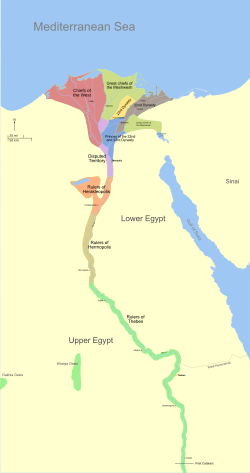
Back Derde Oorgangstydperk van Egipte Afrikaans Dritte Zwischenzeit (Ägypten) ALS فترة مصرية انتقالية ثالثة Arabic عصر الاضمحلال التالت ARZ Üçüncü aralıq dövr (Misir) Azerbaijani اۆچونجو آرا دؤنم AZB Трэці пераходны перыяд (Егіпет) Byelorussian Трети преходен период на Древен Египет Bulgarian Trede marevezh etre Henegipt Breton Tercer Període Intermedi d'Egipte Catalan
Third Intermediate Period of Egypt | |||||||||
|---|---|---|---|---|---|---|---|---|---|
| c. 1077 BC – c. 664 BC | |||||||||
 Political factions fractured ancient Egypt during the Third Intermediate Period. The boundaries above show the political situation during the mid-8th century BC. | |||||||||
| Capital |
| ||||||||
| Common languages | Ancient Egyptian | ||||||||
| Religion | Ancient Egyptian religion | ||||||||
| Government | Monarchy | ||||||||
| Pharaoh | |||||||||
• c. 1077–1052 BC | Smendes (first) | ||||||||
• c. 664–656 BC | Tantamani (last) | ||||||||
| History | |||||||||
• Began | c. 1077 BC | ||||||||
• Ended | c. 664 BC | ||||||||
| |||||||||
| Today part of | Egypt Sudan | ||||||||
| Periods and dynasties of ancient Egypt |
|---|
|
All years are BC |
The Third Intermediate Period of ancient Egypt began with the death of Pharaoh Ramesses XI in 1077 BC, which ended the New Kingdom, and was eventually followed by the Late Period. Various points are offered as the beginning for the latter era, though it is most often regarded as dating from the foundation of the Twenty-Sixth Dynasty by Psamtik I in 664 BC, following the departure of the Nubian Kushite rulers of the Twenty-fifth Dynasty after they were driven out by the Assyrians under King Ashurbanipal. The use of the term "Third Intermediate Period",[1] based on the analogy of the well-known First and Second Intermediate Periods, was popular by 1978, when British Egyptologist Kenneth Kitchen used the term for the title of his book on the period. While Kitchen argued that the period was 'far from being chaotic' and hoped that his work would lead to the abolishment of the term, with his own preference being the 'Post-Imperial epoch', his use of the term as a title seems only to have entrenched the use of the term.[2]
The period was ruled by non-native Egyptians and is viewed as one of decline and political instability including division of the state, coinciding with the Late Bronze Age collapse of civilizations in the ancient Near East and Eastern Mediterranean (including the Greek Dark Ages).
- ^ Schneider, Thomas (27 August 2008). "Periodizing Egyptian History: Manetho, Convention, and Beyond". In Klaus-Peter Adam (ed.). Historiographie in der Antike. Walter de Gruyter. pp. 181–197. ISBN 978-3-11-020672-2. Archived from the original on 18 February 2020. Retrieved 26 December 2019.
- ^ Cite error: The named reference
:0was invoked but never defined (see the help page).